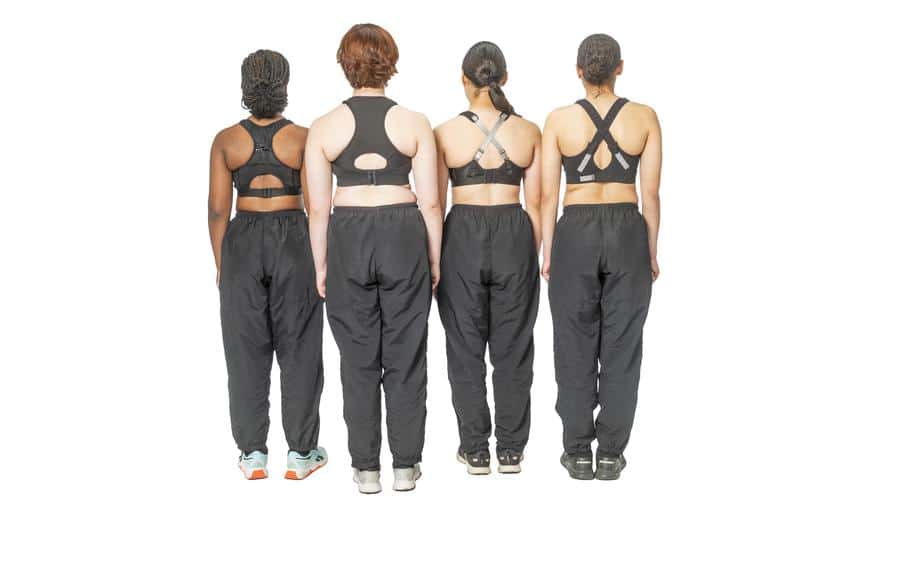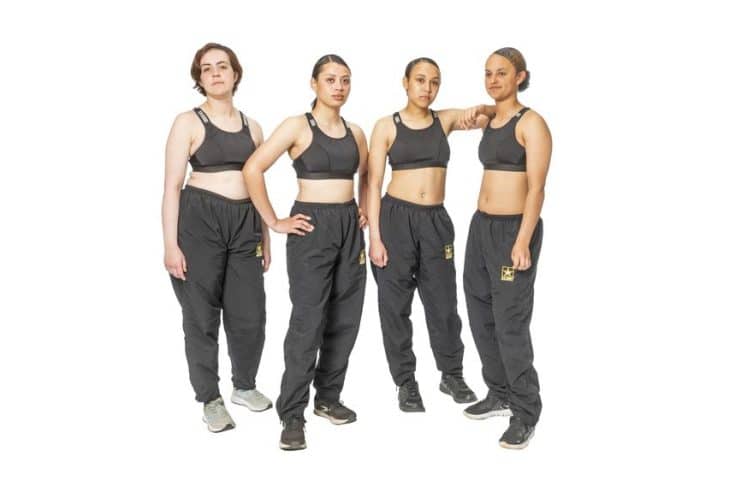Veterans say it is long overdue.

When Sarah Hoyt arrived at Fort Jackson, S.C., for basic training in 2002, the Army confiscated all of her personal belongings. That included sports bras she had packed for the 10 weeks of strenuous physical activity that stretched ahead of her, she said.
If she wanted new ones, she had to visit a reception station, which sold just one brand and one style, said Hoyt, now 41 and an Army veteran living at Camp Humphreys, South Korea.
“If racerbacks were uncomfortable for you, too bad. If you needed more support, too bad. If the store was out of your size, too bad,” she said.
So for the first few days of the training program, Hoyt pushed through the discomfort of too-small bras as she cycled through sit-ups, pushups and two-mile runs. “I was very uncomfortable, to put it mildly,” she said. “They did a good job of putting the girls down, but it was so tight.”
Now 20 years later, the Army is poised to offer its first official uniform bra in an effort to address challenges like the ones Hoyt faced, as well as equip female soldiers with better options for combat and training use.
“The overall goal is to produce garments that not only protect the user, but reduce the cognitive burden on the female Soldier caused by discomfort and ill fit,” clothing designer and project lead Ashley Cushon told Army AL&T magazine. “Achieving this will improve the Soldier's overall readiness and performance levels, allowing them to focus on their mission.”

Four prototypes of the bra, known as the Army Tactical Brassiere (ATB), are in development at the U.S. Army Combat Capabilities Development Command Soldier Center in Natick, Mass., and final concepts will be presented to the Army Uniform Board for approval in the fall. The designs all offer flame-retardant protection and vary in other features, which include pullover and front-closure styles, structured and contoured seams, adjustable straps, padded cups, mesh venting and an inner dog-tag pocket.
“If the ATB becomes an official Program of Record as a result of the upcoming Army Uniform Board, we would see that as a win for female Soldiers across the Army, who would then likely be issued the ATB upon initial entry to the Army,” David Accetta, a public affairs officer for Devcom Soldier Center, wrote in an email to The Washington Post.
The project joins a wave of recent efforts to recognize the diversity of service members and improve uniform standards for women, who made up 16.5% of the enlisted forces in 2018. Last year, the Army and the Air Force released new rules that allow more flexibility for service members who wear locs, twists, braids and ponytails. And last month, the Navy measured hundreds of sailors in Norfolk, in its ongoing effort to create better-fitting uniforms for female personnel.
Madelynn Conner, a 24-year-old intelligence officer stationed in Vicenza, Italy, said she and colleagues appreciate the Army's latest initiative. “We are very grateful that the Army is moving in this direction and being more accommodating towards its female soldiers, who bring so much to the fight,” she said. “I personally hope to see similar developments for items such as the frame for our rucks, allowing them to adjust more appropriately to our bodies.”
Across social media, veterans have also expressed their excitement.
“I needed these in 1997 in Basic Training,” one user commented on Facebook. “Glad the Army is finally taking a woman's needs seriously.”
Others have criticized the move.
“I can think of a million better ways for the Army to spend this time, money, and energy,” a user tweeted. “Who asked for this.”
According to Accetta, hundreds of female soldiers were surveyed to provide insight on the type of functionality and preferences the Design, Pattern and Prototype team at Devcom Soldier Center should consider during initial design.
Early on in the process, the team also hired Jené Luciani-Sena, author of “The Bra Book,” to offer consultation on what makes a good bra.
Based on images of the four concepts Devcom Soldier Center released to the public, “it looks like they're on the right track,” Luciani-Sena said, adding that the Army is focused on developing bras for functionality first. “However, I do know based on my conversations with them that they do want the women to feel good in them, too, and they are being cognizant of that.”
Although she was initially excited about the development of the bras, Hoyt admits she's worried the Army hasn't made significant progress in size inclusivity — largely because of her own experiences with “Army bras” in the past.
In 2004, she was issued three sports bras for her deployment to Iraq. The sizes came only in small, medium, large and extra large, Hoyt said.
Now she's concerned the ATB will use similarly restrictive measurements. “To attempt to shoehorn women's body parts into such rigid size categories is planning to fail,” she said. Devcom Soldier Center did not immediately have information about size ranges the bra will offer, but the team reviewed data collected from a 2012 Army Anthropometric survey, which “provided significant data on the relative size of our Soldiers,” Accetta said.
“There are definitely some unique issues that we face when it comes to bras,” said Connor, the officer in Italy. “Things that we would like to see in a good tactical bra include breathability — since we spend a lot of time in the field and oftentimes go weeks without a shower — good support without the suffocation … and bras that do not cut into our skin or cause chafing and blisters.”
Devcom's early findings on ATB performance among more than 200 participants show acceptability ratings from 46% to 78%. The highest-ranking attributes were coverage and support. Meanwhile, comfort was listed as the lowest.
Luciani-Sena stresses that there's no one-size-fits-all when it comes to making the perfect bra.
“I can tell you what I think is good from an expert standpoint,” Sena said. “But it's going to be so personal to you — what you like and what you feel is good for you.”
For Hoyt, it's pullover bras with crossback straps. And “the absolute best are the ones with the front crossover for extra support,” she added.
Looking back at her time at basic training, Hoyt recalls the gratitude she felt when her mom mailed her comfortable sports bras to wear for the remainder of the program.
“I ripped the package open in front of the entire platoon and both [of my] male drill sergeants,” Hoyt said. “I was so happy.”
Now she hopes others can find that same relief: “We know what we like and what works best for our unique bodies.”
Read the original article in its entirety at stripes.com.



I hope that these gals are expected to put on their Military Bras, Combat boots, load their weapons and fight.
So are they now issuing supporters with protection for male genitalia? Viet nam era was just boxer shorts… not good.
I realize that this is probably over due. Men do not really have this problem which is why women generally have not been put in a situation where it was important. Now that we seem to have crossed that bridge, we don’t need any soldiers distracted by their uniforms when they already have full plate of distractions with the shenanigans of their superior officers. What I would like to know is if this is something that is going to be another cost associated with “trans” soldiers? Sounds like not only will we be footing the bill for their surgeries and such, but if they are growing extra appendages, the clothes to deal with that too. Why? And despite what they say, diversity in the military is not necessarily the best thing. This in some ways is beyond diversity to madness.
We humans are mammals. That means we are male and female. Except for those exceedingly rare individuals actually born as transsexuals all others who “identify” as “transsexual” are either crossdressing homosexuals suffering from the mental disorder sexual dyslixia or pretending to be to scam the system. It’s science and biology; not Harry Potter magic as anyone whose actually passed a course in basic biology can attest to. Since it’s medicly as well as scientificly impossable to change a humans sex as a DNA test or skelatial x-ray of the pelvic region can easly revial.
Let’s see. We’re developing “tactical” brassieres for women, searching for extremists and sensitizing the troops, and throwing trained and experienced soldiers out for saying no to vaccines. Guess the Army doesn’t have time to train for war. Our Red Chinese enemies are probably laughing themselves silly and can’t believe their good fortune.
ex-SSG Infantry
USA
I’m not sure she’s thinking straight. Pull-over style and some racer-backs can be dufficult to remove, especially when sweaty.
China’s building hypersonic missiles and our Armed Forces are building “tactical bras”. I wonder if they’ll fit the soldiers that we are paying for their medical to “Transition”. The Chinese and the Russians are rolling on the ground laughing…..
They are tactical bra’s that can be used as slings to intercept hypersonic missiles.
The Russians are invading the Ukraine and accusing NATO of attacking Russia through surrogates. The Chinese are threatening the peace in SE Asia by aggressive moves towards Taiwan. Meanwhile, here in the USA, we are concerned about “Tactical Bras”. I bet this is causing concern among the Russian and Chinese military.
I’m a veteran and I’m NOT aware of the ARMY taking anyone’s bras away. This is B.S.
The Armed Forces wanted lots of wimmen, so now let the buggers pay the price. NOW, when they enlist lots of queeps and trannies, what price will they pay? Think about it.
It looks better on Milley!